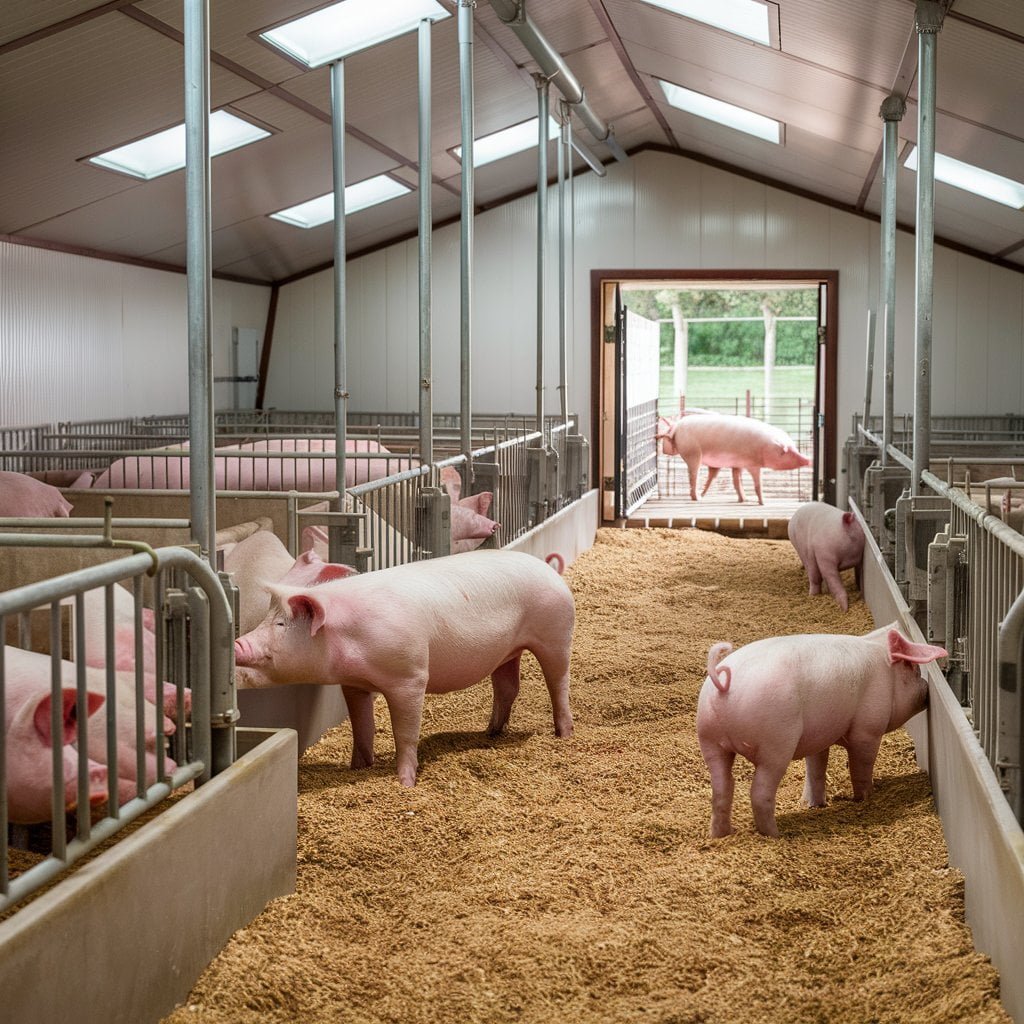Swine housing systems and materials are critical to the health, productivity, and welfare of pigs. Effective housing solutions ensure proper environmental conditions, such as temperature regulation, ventilation, and cleanliness. Materials for swine housing, such as concrete, metal, and durable plastics, must be strong, easy to clean, and resistant to wear and corrosion. Pig pens, farrowing crates, and nurseries that are properly designed and constructed improve animal welfare and promote efficient management procedures, resulting in higher growth rates and overall swine health.
Table of Contents
Introduction
Swine housing systems and materials are critical to the health, productivity, and welfare of pigs. These systems are intended to provide optimal living circumstances, protect pigs from inclement weather, and permit simple management and cleaning. Here is a summary of the most typical swine housing methods and materials:
Types of Swine Housing Systems

Swine housing systems are divided into three types: indoor confinement systems, outdoor systems, and hybrid systems, each with its own set of advantages and disadvantages. The housing system used has a considerable impact on animal welfare, productivity, and the environment.
1. Indoor Confinement Systems
Indoor confinement techniques include farrowing crates, gestation stalls, and finishing barns. Farrowing crates are intended to shield piglets from being crushed by the sow, whilst gestation stalls are used to house pregnant sows individually in order to check their health and nutrition. Finishing barns are commonly used to raise pigs until they reach market weight. These controlled environments enable effective temperature, ventilation, and hygiene management, hence reducing illness risks and optimizing growth rates. Indoor systems, on the other hand, frequently receive criticism for constraining natural activities and may necessitate large capital expenditure.
2. Outdoor Systems
Outdoor systems, such as pasture-based and deep-bedded systems, provide a more natural environment for pigs. Pasture-based systems allow pigs to wander freely and forage, encouraging physical activity and natural behavior. Deep-bedded systems use materials such as straw to produce a comfortable bedding area while also providing insulation and absorbing waste. These systems are often seen as more compassionate and environmentally beneficial because they improve soil health and lessen waste management difficulties. However, they may provide a greater risk of disease exposure and necessitate more space and work.
3. Hybrid Systems
Hybrid systems integrate features of both indoor and outdoor installations, attempting to balance the advantages of each. For example, pigs may have access to indoor shelters for resting and feeding while being free to roam outside during the day. This strategy can improve animal welfare by creating a more exciting environment and lowering stress. Hybrid systems can also provide greater flexibility in management techniques and resource allocation. However, they may necessitate more complicated infrastructure and rigorous maintenance to achieve optimal circumstances.
Materials Used in Swine Housing
When building swine housing, choosing the right materials is critical because it directly affects the facility’s durability, hygiene, and general administration. The materials used for swine housing must be long-lasting, easy to clean, and safe to ensure that the environment is both sustainable and beneficial to the livestock’s health and productivity.
1. Flooring
- Concrete: Durable and simple to clean, usually found in traditional barns. Slatted floors allow garbage to fall through, but solid floors do not.
- Plastic slats: Often used in farrowing and nursery buildings to make cleaning easier and piglets more comfortable.
- Rubber mats: Increase comfort and lessen joint tension; commonly utilized in high-traffic areas.
2. Walls and partitions
- Concrete: Durable and simple to disinfect, typically used for barn walls.
- Metal panels: Frequently used as partitions in pens and crates, giving durability and simplicity of cleaning.
- Plastic or PVC panels: Some modern facilities make use of lightweight and easy-to-clean materials.
3. Roofing
- Metal sheets: Durable and long-lasting, typically found in traditional barns.
- Fabric (for hoop barns): Outdoor systems benefit from its flexibility and natural lighting.
4. Bedding materials
- Straw: Commonly used in deep litter systems and outdoor shelters.
- Wood Shavings: They provide good absorption and are employed in some indoor systems.
- Sand: It is sometimes utilized in deep-bedding systems due to its cooling and comfort characteristics.
5. Feeding and watering systems:
- Automated feeders: Pigs should be fed in constant and measured amounts to reduce waste and labor.
- Nipple Waterers: Ensure a consistent supply of clean water, reducing contamination and wastage.
- Troughs: They can be used for both feeding and watering, but must be cleaned on a regular basis to avoid infection.
Designing an Efficient Swine Housing System
Designing an efficient swine housing system is critical for improving livestock management and maintaining productivity and animal health. This method takes into account important factors such as spatial needs, ventilation systems, waste management, and biosecurity controls. Each of these components contribute significantly to the creation of an environment that promotes swine health and growth.
Ventilation systems are essential for ensuring air quality in swine housing. Proper ventilation aids in controlling temperature, humidity, and the concentration of hazardous gases like ammonia and carbon dioxide. Implementing modern temperature control systems can help to improve these efforts by providing a constant and comfortable environment year-round. This not only improves animal health, but also increases output by lowering stress and preventing respiratory problems.
Another critical aspect of efficient swine housing design is effective waste management. Systems should be in place to handle manure and other waste products in an environmentally friendly and disease-free manner. This can include automated garbage removal systems, composting, and bio-digesters for energy production. Proper waste disposal not only provides a cleaner environment for the swine, but it also adds to sustainable farming techniques.
Biosecurity measures are critical to preventing disease introduction and transmission in the swine herd. This includes regulating access to the living facilities, following regular cleaning and disinfection practices, and monitoring the animals’ health. Implementing stringent biosecurity practices can dramatically lower the likelihood of outbreaks while also protecting the overall health of the herd.
Technology has a significant impact on the efficiency of swine housing systems. Automated feeding and watering systems ensure that critical nutrients and water are delivered consistently and on time. Climate control systems, along with real-time monitoring, enable exact changes to ambient conditions. Advanced monitoring systems can measure health indicators such as weight increase and activity levels, providing useful information for making sound management decisions.
Frequently Asked Question(FAQ)
What are the main types of swine housing systems?
The main types of swine housing systems are: Conventional Barns, Group Housing, Outdoor Systems.
What materials are commonly used in swine housing?
The commonly used in swine housing are: Flooring, Walls and Partitions, Roofing, Bedding Materials.
Related Articles

